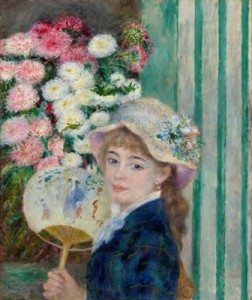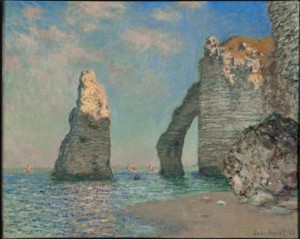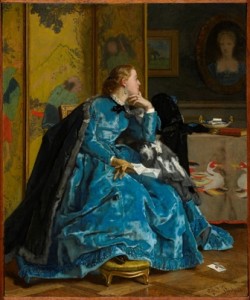
Pierre-Auguste Renoir (French, 1841–1919), Girl with a Fan, c. 1879. Oil on canvas, 65.4 x 54 cm. © Sterling and Francine Clark Art Institute, Williamstown, Massachusetts, USA, 1955.595
(WILLIAMSTOWN, Mass.) – Continuing its commitment to global outreach and cultural exchange, the Sterling and Francine Clark Art Institute opens the exhibition La Collection Clark à Giverny, de Manet à Renoir at the Musée des impressionnismes in Giverny, France, as part of the international tour of masterpieces from its collection of nineteenth-century European paintings.
Open to the public from July 13 through October 31, the exhibition represents a unique opportunity to present many of the greatest works from the Clark’s extraordinary holdings of French Impressionist paintings in their country of origin, particularly notable given Giverny’s central role as a base of activity for many of the most noted artists of the Impressionist movement. The Musée des impressionnismes is located within walking distance of the famed house and gardens of Claude Monet, the inspiration for many of the artist’s most noted works.
The exhibition at Giverny features 72 paintings, including works by Pierre-Auguste Renoir, Claude Monet, Edgar Degas, Édouard Manet, Berthe Morisot, and Camille Pissarro, as well as those by Pierre Bonnard, Jean-Baptiste-Camille Corot, Paul Gauguin, Jean-François Millet, Alfred Sisley, Henri de Toulouse-Lautrec, William-Adolphe Bouguereau and Jean-Léon Gérôme.
“It is a rare and wonderful opportunity for the Clark to present many of our great French paintings at the Musée des impressionnismes, and to consider these works in the seminal setting of Giverny is particularly compelling,” said Clark director Michael Conforti. “We are so pleased to share some of the Clark’s best-known and most beloved works with a broader global audience. This exhibition also allows us to honor the deep and important ties to France that have been vital to the Clark’s history and to the many cross-cultural programs that are central to our current activities.”

Claude Monet (French, 1840–1926), The Cliffs at Étretat, 1885. Oil on canvas, 65.1 x 81.3 cm. © Sterling and Francine Clark Art Institute, Williamstown, Massachusetts, USA, 1955.528
The museum’s founder, Sterling Clark, moved to Paris in 1910, met and married his wife Francine Clary, an actress in the Comédie Française, and together they began to collect works by many of the most noted French painters of the era. The couple lived in an apartment in the sixteenth arrondissement in Paris for more than thirty years, and owned a horse farm in the countryside of Normandy.
Today, the Clark maintains close connections with museums and cultural organizations throughout the world. The Clark has long played a leadership role in the French Regional & American Museum Exchange (FRAME), a consortium of twenty-six museums in France and North America that promotes cultural diplomacy in the context of museum exchanges. FRAME fosters partnerships among its member museums to develop exhibitions, innovative educational and public programs, and professional exchanges among museum staff. The Clark has curated and hosted a number of exhibitions and events in cooperation with other FRAME museums and is active in a number of its programs. Earlier this year, the Republic of France conferred a Chevalier in its Ordre des Arts et Lettres upon Richard Rand, the Clark’s Robert and Martha Berman Lipp Senior Curator of Paintings in recognition of Rand’s significant contributions to promoting French art and culture.
The Clark’s international tour comes to the Musée des impressionnismes from the Palazzo Reale in Milan, where it garnered critical praise and considerable public attention. The exhibition, on view from March 2 through June 19, drew more than 170,000 visitors over the course of fifteen weeks.

Alfred Stevens (Belgian, active in France, 1823–1906), A Duchess (The Blue Dress), c. 1866. Oil on panel, 31.4 x 26 cm. © Sterling and Francine Clark Art Institute, Williamstown, Massachusetts, USA, 1955.865
The timing of the international tour coincides with the Clark’s preparations to launch the next phase of its campus expansion program and presents an ideal opportunity to share these works with a worldwide audience. After Giverny, the works will travel to CaixaForum in Barcelona, where they will be on view from November 18 through February 12, 2012. Venues in 2012 will include the Kimbell Art Museum in Fort Worth, Texas, from March 4 to June 17, 2012; the Royal Academy of Arts in London from July 7 to September 23, 2012; and the Montreal Museum of Fine Arts in Canada from October 8, 2012 to January 20, 2013. In 2013, the exhibition will move on to venues in Japan and China.
Accompanying the exhibition is the catalogue Great French Paintings from the Clark, published by Skira Rizzoli in spring 2011, with editions in five languages. The 240-page publication, available in hardcover, features 131 color illustrations accompanied by essays by James A. Ganz and Richard R. Brettell.
Sterling and Francine Clark acquired most of the paintings which form the basis of the Clark’s collection. From the 1910s until the 1950s, the Clarks assembled an outstanding collection of European and American paintings, sculpture, and drawings, as well as British silver and European porcelain. The Clark is best known for its collection of French Impressionist paintings, including more than thirty works by Pierre-Auguste Renoir, which take their place within a wider ensemble of masterworks that date from the Renaissance to the end of the nineteenth century. Although the collection has expanded greatly since the opening of the Clark in 1955, including a growing collection of early photography, the scope and character continues to represent the taste and interests of the founders.
The Clark is one of the few major art museums that also serves as a leading international center for research and scholarship. The Clark presents public and education programs and organizes groundbreaking exhibitions that advance new scholarship, and its research and academic programs include an international fellowship program and conferences. Its 140-acre campus in the Berkshires of Western Massachusetts includes Stone Hill Center, designed by Tadao Ando and opened in 2008, which houses galleries, meeting and classroom facilities, and the Williamstown Art Conservation Center. The Clark, together with Williams College, America’s foremost liberal arts college, sponsors one of the nation’s leading master’s programs in art history.
The Clark is located at 225 South Street in Williamstown, Massachusetts. The galleries are open daily in July and August (open Tuesday through Sunday from September through June), 10:00 am to 5:00 pm. Admission is free November through May. Admission is $15 June 1 through October 31. Admission is free for children 18 and younger, members, and students with valid ID. For more information, call 413 458 2303 or visit Sterling and Francine Clark Art Institute.
